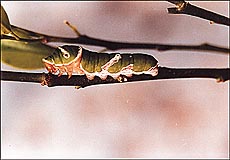Protect your
plants from insects
According
to nature’s time-table, when the new growth of
plants starts, insects too appear. For the best results
from your garden, adopt a scientific approach. Gardening
experts have remedies for your problems. So, keep in
touch with them,
says Satish Narula.
ARE you helplessly looking at your
plants, being damaged by various pests and diseases?
According to nature’s time table when the new growth
of plants starts, insects too appear. Here are a few tips
on how to keep them at bay. But first, a few other
considerations.
 For the best results from your garden,
adopt a scientific approach. Gardening experts have
remedies for your gardening problems. So, keep in touch
with the experts. For the best results from your garden,
adopt a scientific approach. Gardening experts have
remedies for your gardening problems. So, keep in touch
with the experts.
Most of the queries that
we receive these days relate to ladies’ finger. The
leaves turn yellow and fruiting is reduced. This could be
because you have unknowingly procured virus resistant
seeds. Pusa Padmini, a recommended cultivar of Punjab
Agricultural University, is tolerant to yellow mosaic
virus.
Only a few virus
symptoms appear on a new shoots, that too quite late in
the season. Another variety, Punjab-7, has a high degree
of resistance to this virus. Similarly in case of chilli,
Punjab Surkh is moderately resistant to mosaic virus
while Punjab Guchhedar is highly resistant to mosaic and
tolerant to leaf curl virus. Similarly CH-I is tolerant
to virus and fungal diseases, Punjab Lal is resistant to
viruses and moderately resistant to fruit rot and die
back diseases.
Another problem with
ladies’ finger and brinjal is the curling upwards
(cupping) of leaves caused by jassids. Spraying
malathion, sevin endosulfan etc will help. These
chemicals will also take care of the white fly that acts
as a vector (carrier) of virus and spotted boll-worm in
ladies’ finger and badda beetle. Remember, once a
plant has been affected by virus you cannot correct the
fault. You have to uproot the plant to destroy the virus.
Many times it happens
that you pay through your nose to get ‘good
quality’ seed from some ‘good company’.
The problem in such cases , however, is that the seed has
not been tested in a particular region and as a result
you get table tennis ball-sized stiff brinjals or one
inch long ladies finger which turn yellow or varieties
prone to disease and insects. Hence it is important to
get seed from a reliable source.
In case of a citrus, the
lemon butterfly which is a beautiful greenish black
insect with yellow spots, causes considerable damage when
its larvae devour the leaves. The larva grows into an
inch long caterpillar. If you want to be sure that it is
the same insect, just touch it with a small twig on its
head and it will throw out two red extensions to scare
you away. If you do not move away then it will give out
an offensive odour.
Another problem you may
face is of fully ripe guava severely infested with
maggots or fruit-fly. The fruit-fly attacks fruits like
guava when they start ripening and the skin starts
softening.The female lays eggs, puncturing the skin. The
maggots move-in and attack fruit from within. The fruit
drops on the ground and the larvae move underground. They
reappear with the first monsoon shower as adults at a
time when the fruit begins to ripen.
The fruit of the monsoon
season is generally unfit for consumption. The second
crop, that is the winter season crop, is not only free
from the fruit-fly but is also superior to the summer
season crop. In order to get only the winter season crop,
irrigation is withheld during April-May. The tree can
also be sprayed with 10 per cent urea during May.
Fertiliser is given in June to encourage growth in
July-August and get maximum flowering during
August-September.
This
feature was published on August 29, 1999
|

